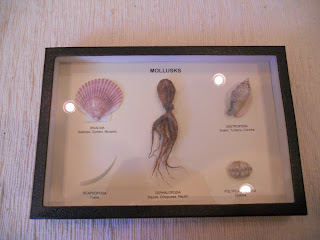 "There is in the child a special kind of sensitivity which leads him to absorb everything about him, and it is this work of observing and absorbing that alone enables him to adapt himself to life. He does it in virtue of an unconscious power that only exists in childhood."
"There is in the child a special kind of sensitivity which leads him to absorb everything about him, and it is this work of observing and absorbing that alone enables him to adapt himself to life. He does it in virtue of an unconscious power that only exists in childhood." -Maria Montessori
The past few weeks, the science shelves have been stocked with lessons focusing on mollusks. The children have busied themselves with using puzzles to learn the parts of a snail/gastropod,

.JPG) making labeled pencil and watercolour drawings of gastropods,
making labeled pencil and watercolour drawings of gastropods,.JPG)

raising a dozen small freshwater pond snails (which began as a cluster of gelatinous eggs attached to the leaves of an elodea plant).

 reading about mollusks,
reading about mollusks,
and looking at some mounted specimens of mollusks.

.JPG)
.JPG) The children were very interested in the classroom shell collection, in particular. Many of them were happily surprised to learn that the Harold Feinstein print which hangs in the classroom is a photograph of a nautilus shell (many of them previously referred to it as "the roly poly"- they automatically assimilated the image into conceptual schemes that were based upon more limited experiences).
The children were very interested in the classroom shell collection, in particular. Many of them were happily surprised to learn that the Harold Feinstein print which hangs in the classroom is a photograph of a nautilus shell (many of them previously referred to it as "the roly poly"- they automatically assimilated the image into conceptual schemes that were based upon more limited experiences). Over the past few weeks, children have been bringing shells (conchs, abalone, limpets, etc) to me and asking questions about the invertebrates that lived in them; I kept responding that the animals were very similar to a snail (having a muscular foot, tentacles, a radula, and eye stalks). Unfortunately, I knew that the answer was a little unfulfilling, given that we seem to have reared the most inactive pond snails I have ever seen (they seldom came out of their shells at all, even with the enticement of food).
So, over Labor Day weekend, we set up a small saltwater aquarium in the classroom. My obliging husband built a small platform for the tank so that it would be the perfect height for the children (so they could easily see the entire tank and so they could sit on their knees for extended viewing). So far, it is stocked with a large Turbo Snail, four Turban Snails, and a Spider Conch. It also contain a few non-mollusk companions (a Mandarin fish, a Midas Blenny fish, a Chocolate Chip Starfish, a Red Tipped Hermit Crab, and a Striped Cleaner Shrimp). After the aquarium has become established, we hope to add a few more interesting creatures for the children to observe.
 Needless to say, the aquarium is very interesting to the children. At practically all times of day, one or more children can be seen crowded around, carefully observing the activity in the tank. I have been tremendously impressed with the quality and exactitude of some of their observations (one four year old boy remarked that the cleaner shrimp liked to stay in the cave and asked whether it might be more active at night, when it was dark- a quick flick of the light switch in the tank and he was able to both test his hypothesis and get a hands on demonstration of the term "nocturnal"). I am very excited about this new addition to our classroom (and happy to have found more interesting snails!).
Needless to say, the aquarium is very interesting to the children. At practically all times of day, one or more children can be seen crowded around, carefully observing the activity in the tank. I have been tremendously impressed with the quality and exactitude of some of their observations (one four year old boy remarked that the cleaner shrimp liked to stay in the cave and asked whether it might be more active at night, when it was dark- a quick flick of the light switch in the tank and he was able to both test his hypothesis and get a hands on demonstration of the term "nocturnal"). I am very excited about this new addition to our classroom (and happy to have found more interesting snails!).



No comments:
Post a Comment